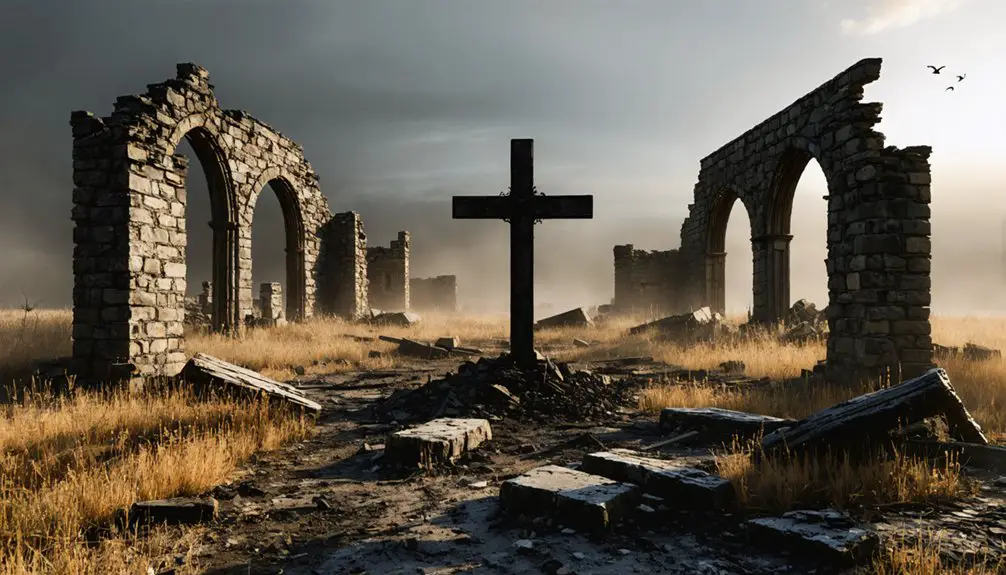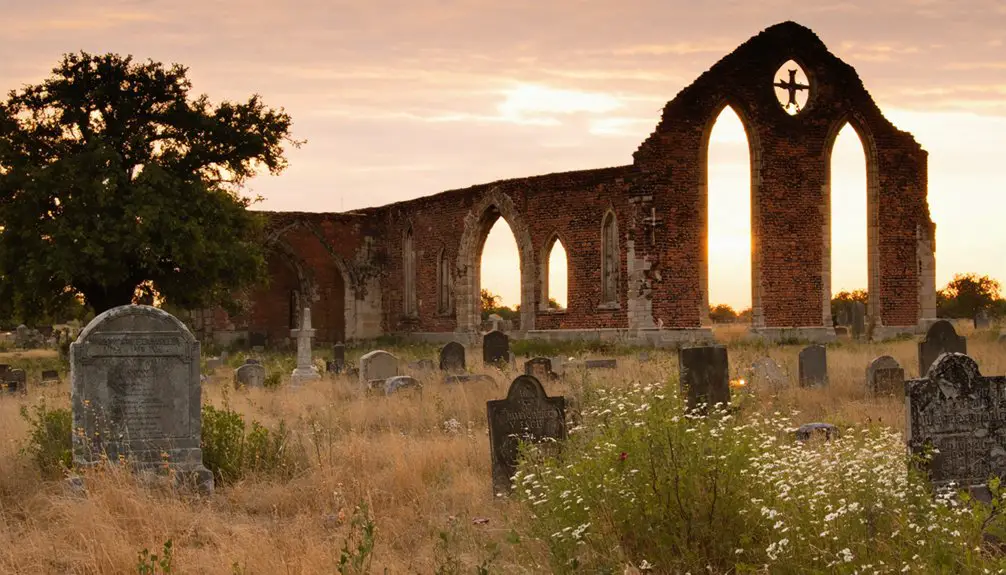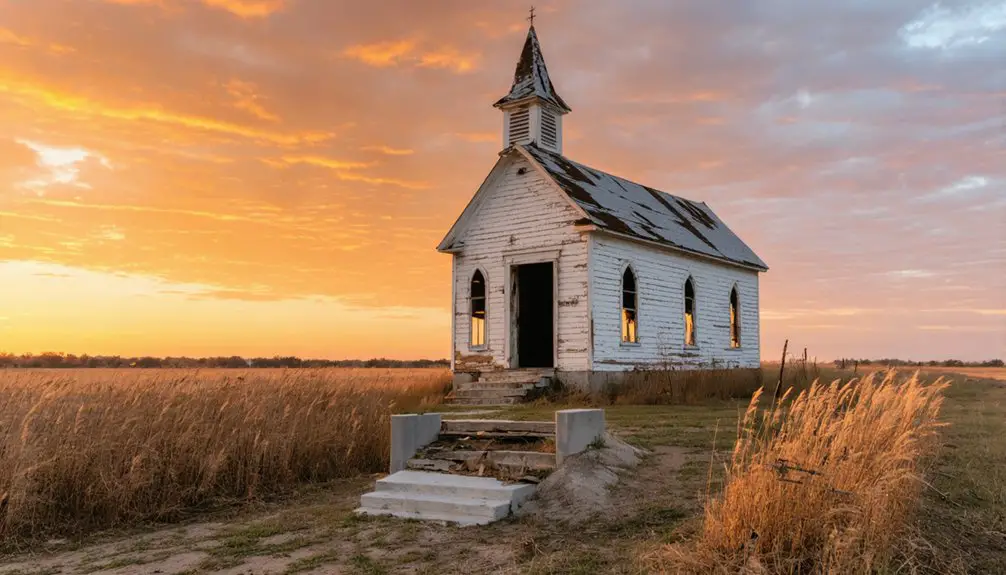You’ll find Sacred Heart Mission‘s haunting ruins about six miles east of Asher, Oklahoma, where Father Isidore Robot established a thriving Catholic settlement in 1876. This ambitious mission included monasteries, schools, and a seminary until a catastrophic fire in 1901 destroyed most buildings. Today, you can explore the remaining stone structures and cemetery, where local legends tell of ghostly monks and mysterious orange glows that still illuminate the historic grounds.
Key Takeaways
- Sacred Heart Mission began in 1876 as a thriving Catholic community with schools, monastery, and seminary before becoming a ghost town.
- A devastating fire in 1901 destroyed most buildings except the stone bakery, marking the beginning of Sacred Heart’s decline.
- The site now contains ruins and foundations of original structures, including the historic bakery building that survived the fire.
- Local folklore includes ghost stories of wandering monks and Native American spirits, with reports of supernatural orange glows.
- Located six miles east of Asher, Oklahoma, the ghost town remains accessible but lacks facilities or maintained infrastructure.
The Birth of Sacred Heart Mission
In the autumn of 1876, a pivotal moment in Oklahoma’s religious history unfolded when Father Isidore Robot secured a tribal land grant from the Citizen Band Potawatomi Indians near Bald Hill. The site, nestled close to the Canadian River in what you’d now recognize as Pottawatomi County, would soon transform into Sacred Heart Mission.
The mission quickly became known for its model farm and gardens, which helped sustain the community and teach agricultural practices.
You’ll find the mission’s goals were ambitious from the start, focusing on cultural integration between Native American and settler communities.
After celebrating their first Mass outdoors on May 13, 1877, Father Robot and Brother Dominic Lambert officially established the mission on June 7, 1877.
On a spring day in 1877, two determined missionaries laid the cornerstone of Oklahoma’s spiritual legacy at Sacred Heart.
They’d create a self-sustaining community that combined spiritual guidance with practical education, setting the foundation for what would become a thriving religious and educational center in Indian Territory.
By 1880, the mission had grown substantially with several key buildings including a monastery, schools, and seminary.
Building a Catholic Haven in Indian Territory
You’ll discover how Father Robot’s Benedictine vision materialized through a unique partnership with the Potawatomi Nation, who granted a square mile of their reservation for the Catholic mission.
The mission’s strategic location at Bald Hill’s western end, four miles north of the Canadian River, would become Sacred Heart’s permanent home in Indian Territory before non-Indian settlement.
Led by Father Dom Isidor Robot, who traveled from Harve, France, the mission established itself as a vital religious and educational center. The first celebration of Mass took place under the open Oklahoma sky in May 1877.
Benedictine Vision Takes Root
The vision of a Catholic sanctuary in Indian Territory became reality when Father Isidore Robot, a French Benedictine monk, established Sacred Heart Mission on May 13, 1877.
You’ll find that Benedictine ideals shaped every aspect of the mission’s development, from its first open-air Mass to the construction of a two-story monastery and schools. Their devotion was exemplified by a Sacred Heart lamp that burned continuously in the monastery chapel.
The monastic community’s spiritual resilience shone through their all-encompassing approach. They’ve built more than just buildings – they’ve created a hub of cultural integration where French, Basque, Irish, and American monks worked alongside Native Americans.
Their educational outreach included both academic and practical training, with a model farm, technical institute, and St. Benedict’s Industrial School. A devastating fire in 1901 nearly destroyed their progress when most of Sacred Heart Mission burned down.
Through the Indian Advocate publication and their tireless missionary work, they’ve transformed Sacred Heart into Oklahoma’s pioneering center of continuous education.
Native Land Grant Partnership
Sacred Heart Mission’s establishment hinged on delicate negotiations between Father Robot and Native American tribes who controlled the territory. You’ll find that these land negotiations respected tribal sovereignty while creating a unique partnership between Catholic missionaries and Native communities in Indian Territory.
The Benedictine monks secured their presence through careful agreements that acknowledged Native land rights, even as federal policies were beginning to erode tribal control. The tribal jurisdiction in eastern Oklahoma continues this historical precedent of respecting Native American authority over their lands.
The Dawes Allotment Act of 1877 would later devastate tribal lands across the region, but these early mission partnerships preserved elements of collective land use and tribal authority.
Unlike the later Dawes Allotment Act that would fragment communal lands, these early mission partnerships preserved elements of collective land use and tribal authority.
The mission became more than just a religious outpost – it evolved into a center where Catholic practices merged with Native communities’ needs, providing education, agricultural support, and social services within the complex landscape of Indian Territory.
Early Mission Complex Development
Under Father Robot’s determined leadership, the mission complex at Sacred Heart took shape rapidly between 1876-1877, transforming a plot of Potawatomi land into Oklahoma’s first Catholic institutional center.
You’d have witnessed the swift construction of essential structures – a monastery, separate schools for Indian boys and girls, and a novitiate rising from the prairie soil.
The mission’s expansion kicked into high gear by 1880, with an extensive educational program that included technical training and seminary studies.
The first Mass, celebrated under open sky on May 13, 1877, marked the beginning of formal religious activities.
St. Benedict’s Industrial School soon emerged as a cornerstone of the complex, operating under government contract and providing both academic and practical education to Native American boarding students.
Daily Life and Education at the Mission
Life at Sacred Heart Mission revolved around a structured daily routine that seamlessly blended education, agriculture, and religious devotion.
You’d find students and residents working side-by-side in orchards, gardens, and workshops, embracing community engagement through hands-on agricultural education. The bustling mission complex included a bakery producing 500 French loaves daily, while the model farm served both as a food source and teaching facility. The two-story log cabin remained a testament to the mission’s early pioneering spirit.
At Sacred Heart Institute and Saint Mary’s Academy, you’d witness an all-encompassing education system that combined academic studies with practical skills.
Students learned blacksmithing, carpentry, and farming alongside their religious instruction and basic studies. The mission’s approach to learning reflected Benedictine values, preparing students for self-sufficiency while integrating them into Catholic traditions.
The Great Fire of 1901

The catastrophic fire that forever changed Sacred Heart Mission began in the dining room of the Indian Boys School on a cold January night in 1901. You can imagine the terror as flames quickly engulfed the entire complex, destroying the monastery, schools, convent, and church.
While official records don’t list casualties, some accounts suggest there were deaths as people fled the inferno. The remaining stone bakery still stands as a lone survivor of the devastating fire.
The fire’s aftermath reshaped Oklahoma’s Catholic landscape. The Benedictines built temporary structures at Sacred Heart but eventually established St. Gregory’s College in Shawnee.
The devastating Sacred Heart fire spurred profound change, pushing Catholic institutions from rural isolation toward Oklahoma’s growing urban centers.
The Sisters of Mercy relocated nearby, founding St. Mary’s Academy. The historical significance of this disaster led to major institutional changes, with Sacred Heart’s educational functions shifting to urban areas.
Today, only the rebuilt church and scattered foundations remain, evidence of a pivotal moment in Oklahoma’s religious history.
Legacy of Father Isidore Robot
You’ll find Father Isidore Robot‘s enduring legacy in the foundations of Oklahoma’s Catholic Church, where his early missionary work established Sacred Heart Abbey as a spiritual and educational center.
His vision for Catholic education took root through the creation of mission schools that would later evolve into prominent institutions like St. Gregory’s College.
As Oklahoma’s first Prefect Apostolic, Robot’s leadership from 1876 to 1887 created a lasting religious framework that shaped the territory’s development through more than 40 parishes and missions.
Early Missionary Vision
Missionary Father Isidore Robot laid the cornerstone of Oklahoma’s Catholic heritage when he arrived in Atoka, Choctaw Nation in 1875.
Despite missionary challenges in the untamed territory, he quickly established diplomatic relations with Choctaw and Potawatomi chiefs, demonstrating his commitment to cultural integration.
You’ll find his vision reflected in the strategic selection of Sacred Heart as his headquarters, where he’d build both a monastery and schools.
- Established Sacred Heart as a spiritual and educational center for Native American communities
- Created a network of over 40 parishes and missions throughout Indian Territory
- Founded churches along railroad lines and in mining communities to serve diverse populations
Robot’s ambitious vision transformed the spiritual landscape of Indian Territory, earning him papal recognition and establishing a Catholic foundation that would serve generations to come.
Educational Leadership Impact
After accepting his role as the first Apostolic Prefect of Indian Territory in 1876, Father Robot transformed Oklahoma’s educational landscape through ambitious institution-building.
His educational outreach began at Sacred Heart Abbey, where he established a mission church and school serving the Potawatomi people. You’ll find his legacy in the numerous parishes and schools he founded, which grew to include over 40 religious communities across the territory.
His vision for community integration shone through his establishment of educational institutions that served both Native Americans and settlers.
The schools he founded, including what would become St. Gregory’s University, provided both religious instruction and literacy education. These institutions became essential community centers, particularly in coal mining towns and along railroad routes, where they fostered social development and cultural exchange.
Lasting Religious Foundation
When Father Isidore Robot established Sacred Heart Abbey in 1875, he laid the cornerstone of Oklahoma’s Catholic foundation that would flourish for generations.
As the first Apostolic Prefect of Indian Territory, his vision created a religious symbolism that transcended the physical structures, fostering community resilience through a network of over 40 parishes and missions.
- Sacred Heart Abbey served as the spiritual hub for Potawatomi Indian country and regional Catholic outreach.
- Robot’s missionary model balanced monastic life with frontier evangelization.
- The rebuilding after the 1901 fire demonstrated the determination to preserve his legacy.
You’ll find his enduring impact in today’s thriving Catholic communities across Oklahoma, from the remains at Sacred Heart Mission to the vibrant parishes that grew from his original mission churches.
Unexplained Phenomena and Ghostly Tales
Sacred Heart Mission’s haunted reputation stems from its tragic 1901 fire and decades of unexplained phenomena that followed.
You’ll find accounts of ghostly encounters throughout the grounds, from wandering monks to Native American spirits that are said to linger near the mission’s ruins.
Paranormal investigators have documented various spectral sightings, including unexplained water sounds in the abandoned bakery and mysterious cold spots throughout the remaining structures.
Reports often mention the eerie presence of children’s spirits near the old graveyard, while animals exhibit unusual behavior when visiting the grounds.
Local folklore speaks of an orange supernatural glow during the historic fire, and some believe not everyone escaped the flames that day.
These stories, combined with physical manifestations and atmospheric anomalies, continue to draw ghost hunters to this remote location.
What Remains Today

Today, visitors to the historic Sacred Heart site will find only scattered remnants of what was once a thriving Catholic community.
You’ll discover two preserved cemeteries and an old house that stands as a symbol of the town’s historical significance. While most structures have succumbed to time, informative signs with vintage photographs help you envision the bustling community that once existed here.
- One original house remains standing, connecting you to the past
- Two historic cemeteries preserve the community’s legacy
- The old bakery building still marks the original townsite
The community impact lives on through the newer Sacred Heart church located outside the original town, where active worship continues.
You’ll want to visit during daylight hours, as the 2WD-accessible roads and rural setting make nighttime exploration challenging.
Visiting the Historic Site
Planning your visit to this historic ghost town requires some preparation, as the site lies about six miles east of Asher, Oklahoma.
You’ll need to take State Highway 39 and head north on Sacred Heart Road, using GPS coordinates (35.00111°N, 96.80917°W) for accurate navigation.
For visitor preparation, remember there’s no visitor center, maintained parking, or facilities on-site.
You’re free to explore at your own pace, but bring water and wear protective clothing. The rural terrain can be challenging, especially after rain, so a high-clearance vehicle is recommended.
During your exploration, you’ll find minimal signage, so research the site’s history beforehand.
While photographing the remnants is permitted, respect the site’s cultural significance and avoid disturbing any structures or artifacts.
Notable Landmarks in the Region

Several historical landmarks dot the landscape around this abandoned mission town, with the most prominent being the weathered ruins of Sacred Heart Mission itself.
You’ll find sacred landmarks throughout the area, including the historic graveyard where both settlers and Native Americans rest. The site’s rich history draws visitors seeking ghostly encounters among the deteriorating foundations of the church and school buildings.
- Original mission structures showcase 19th-century Catholic architectural design
- Ancient Native American trails still visible in the surrounding forest
- Historic cemetery featuring weathered grave markers and cultural significance
As you explore, you’ll discover traces of the old trade routes and natural features that once supported this thriving religious and educational center.
The mission’s layout reveals the unique blend of French Catholic and Native American influences that shaped this remarkable piece of Oklahoma history.
Frequently Asked Questions
How Many Students Attended Sacred Heart Mission at Its Peak Enrollment?
You’ll find that student demographics and enrollment trends aren’t precisely documented, but historical records suggest the mission’s peak likely included several hundred students across its day school, boarding facilities, and college programs.
What Indigenous Languages Were Taught Alongside English at the Mission Schools?
You won’t find evidence of native language preservation or cultural exchange at Sacred Heart Mission – they enforced English-only policies and actively discouraged Indigenous languages, including Potawatomi, following standard assimilation practices.
Did Any Famous Historical Figures Ever Visit Sacred Heart Mission?
While you might expect famous visitors at such a historically significant mission, records don’t show any nationally known figures stopped there – except Tony Hillerman, who was baptized there in 1925.
What Happened to the Mission’s Original Religious Artifacts After the Fire?
You won’t find the original artifacts – they were lost forever in the fire’s aftermath. No records show any successful artifact preservation efforts before or during the devastating 1901 blaze.
Were There Any Documented Conflicts Between Settlers and Native Americans Here?
Like a calm oasis, you won’t find direct evidence of settler resistance or native conflicts in Sacred Heart’s records. The mission’s archives show mostly peaceful religious activities between communities during the early 1900s.
References
- https://www.okhauntedhouses.com/real-haunt/sacred-heart-mission-site-cemetery.html
- https://accessgenealogy.com/oklahoma/sacred-heart-mission-church-konawa-oklahoma.htm
- https://en.wikipedia.org/wiki/Sacred_Heart
- https://kids.kiddle.co/Sacred_Heart
- https://stgreg-shaw.solutiosoftware.com/about/our-history/5-our-history
- https://www.okhistory.org/publications/enc/entry?entry=SA004
- https://stgreg-shaw.solutiosoftware.com/about/our-history/34-sacred-heart-abbey-school
- https://sites.rootsweb.com/~okpcgc/towns/sacred_heart.html
- https://www.loc.gov/item/ok0110/
- https://monksok.org/about/our-history/5-our-history



